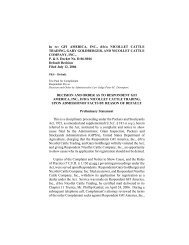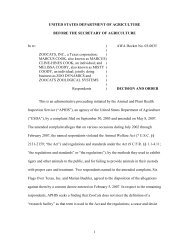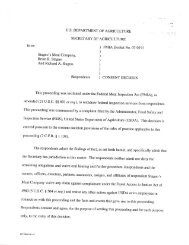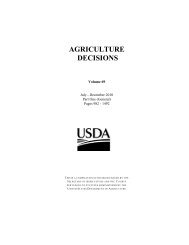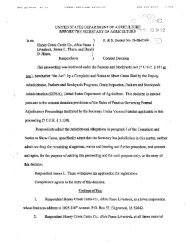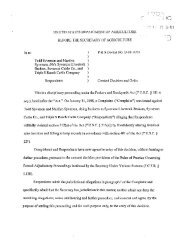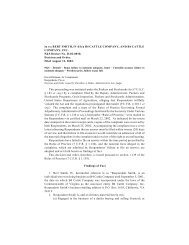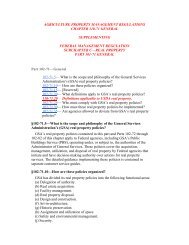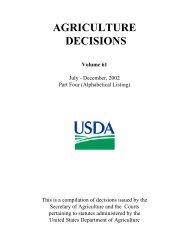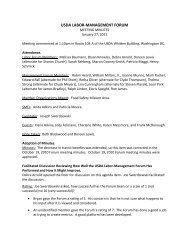Green Information Technology Strategic Plan - Departmental ...
Green Information Technology Strategic Plan - Departmental ...
Green Information Technology Strategic Plan - Departmental ...
Create successful ePaper yourself
Turn your PDF publications into a flip-book with our unique Google optimized e-Paper software.
8.4 <strong>Green</strong> Buildings<br />
Focusing on six major themes uSDA will develop as a<br />
growing and sustainable part of the environment and still<br />
benefit the needs of work, They include 21 :<br />
n Renewable Resource Systems;<br />
n Non-Renewable Resource Systems;<br />
n Long-Term Chemical and Biological Impacts;<br />
n Human-Built Systems and Land Use;<br />
n Economics and Human Behavior; and<br />
n <strong>Information</strong> and Decision Making.<br />
Other Benefits<br />
The critical point of these benefits, is when USDA is able to<br />
integrate all of the cost and environmental efficient ideas and<br />
principles that have been developed through technological<br />
advances. The result of this integration will result in<br />
Smart buildings. Smart buildings, whose core is integrated<br />
building technology systems, are about construction and<br />
operational efficiencies and enhanced management and<br />
occupant functions 22 .<br />
Smart buildings will deliver energy control and energy cost<br />
savings beyond that of traditional system installation, due<br />
to the tighter control system integration. Smart and green<br />
buildings deliver the financial and conservation benefits of<br />
energy management. One question then is how do smart<br />
buildings make a building green? More specifically, how can<br />
smart buildings support and effect the LEED certification<br />
of a green building? There are three prerequisites that each<br />
building must meet prior to any rating 23 :<br />
n Fundamental commissioning of the systems<br />
n Minimum energy performance<br />
n The reduction of chlorofluorocarbons (CFCs) in HVAC<br />
and refrigerant equipment (related to ozone depletion).<br />
Supporting Environmentally Responsible <strong>Technology</strong> at USDA<br />
Smart buildings will optimize energy performance. The<br />
focus is obviously on HVAC and interior lighting systems<br />
(referred to as “regulated” systems), both of which fall under<br />
the umbrella of a smart building. Other systems are referred<br />
to as “unregulated” systems and include plug loads. Plug<br />
loads are everything that plug into the electrical distribution<br />
system, such as PC’s, displays, cameras, vending machines,<br />
copiers, etc. Plug loads make up 9-20% of a typical<br />
building’s electrical load, depending on the building type<br />
and density of devices. Buildings can receive “innovation”<br />
credits if the energy consumption of the non-regulated<br />
systems such as plug loads is also reduced. Enter a smart<br />
building where an IP network is able to provide power-over-<br />
Ethernet (POE) to a range of “plug load” devices. POE not<br />
only supplies low voltage rather than high voltage power to<br />
these devices but, more importantly, provides the means to<br />
control power to the device. Central control of the POE<br />
devices allows for devices to be turned on or off based on<br />
a predetermined schedule, a sensor, or an event, such as an<br />
occupant’s use of an access card. The result can be reduced<br />
consumption of power to devices, reduced power usage<br />
and a greener building. In addition POE reduces the use of<br />
materials, eliminating the need to provide a power cable to<br />
the device 24 .<br />
A Carbon Dioxide (CO 2 ) Monitoring system can provide<br />
data on the ventilation of spaces which then can be used to<br />
adjust the HVAC system. The result is improved indoor air<br />
quality and occupant comfort. The monitoring sensors can<br />
be designed based on activity levels, zones, or space use and<br />
then integrated in the building automation system, therefore<br />
becoming part of a smart building 25 .<br />
59




